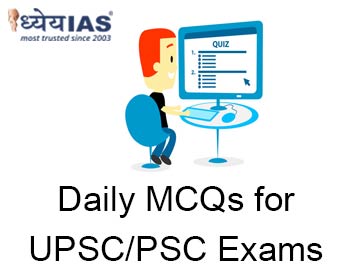Home > Daily-mcqs
Daily-mcqs 19 May 2025

Q1:
With reference to the Artemis Accords, consider the following statements: How many of the above statements are correct?
A: Only one
B: Only two
C: All three
D: None
Answer: B
Explanation:
Statement 1 is incorrect – the Artemis Accords are non-binding and not under UN authority.
Statement 2 is correct – transparency and data-sharing are key principles.
Statement 3 is correct – resource utilization is promoted, in alignment with the Outer Space Treaty.
Thus, two statements are correct.
Q2:
Match the following butterflies with their notable features: List I (Species) List II (Associated Feature) A. Papilio solstitius 1. Appears near summer solstice B. Bhutanitis lidderdalii 2. Known as the Bhutan glory C. Teinopalpus imperialis 3. Also called Kaiser-i-Hind D. Papilio slateri 4. Commonly called Blue-striped mime How many pairs are correctly matched?
A: Only one
B: Two pairs
C: Three pairs
D: All four
Answer: D
Explanation:
Each species listed is matched accurately:
Q3:
Match the following genome editing tools with their characteristics: Tool Characteristic A. CRISPR-Cas9 1. Uses guide RNA for sequence recognition B. ZFN 2. Uses Cys2-His2 zinc-finger motifs with FokI nuclease C. TALEN 3. Uses TALE proteins to target specific DNA sequences D. Homing Endonuclease 4. Non-modular structure limits ease of repurposing How many pairs are correctly matched?
A: Only one
B: Only two
C: Only three
D: All four
Answer: D
Explanation:
All four pairs are correctly matched:
Q4:
With reference to the Tsarap Chu Conservation Reserve, consider the following statements: How many of the above statements are correct?
A: Only one
B: Only two
C: Only three
D: All four
Answer: C
Explanation:
Statements 1, 2, and 4 are correct. Tsarap Chu is in Spiti Valley, a cold desert in Himachal Pradesh, and is India's largest conservation reserve as of May 2025. It links Kibber and Chandratal Wildlife Sanctuaries, forming a vital wildlife corridor. However, Statement 3 is incorrect: Tsarap Chu lies in Himachal Pradesh, not Jammu and Kashmir.
Q5:
Which of the following deserts lies primarily in Saudi Arabia and is one of the largest continuous sand deserts in the world?
A: Thar Desert
B: Negev Desert
C: Rub' al Khali
D: Dasht-e Kavir
Answer: C
Explanation:
The Rub' al Khali, also known as the Empty Quarter, is located primarily in southern Saudi Arabia and stretches into UAE, Oman, and Yemen. It is the largest continuous sand desert in the world. The Thar is in India–Pakistan, Negev in Israel, and Dasht-e Kavir in Iran.